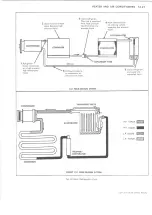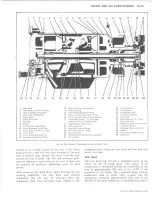
1A-40 HEATER A N D AIR C O N D IT I O N I N G
• Cylinders or disposable cans should never be
subjected to high temperature when adding
refrigerant to the system. In most instances, heating
the cylinder or can is required to raise the pressure
in the container higher than the pressure in the
system during the operation. It would be unwise to
place the cylinder on a gas stove, radiator or use a
blow torch while preparing for the charging
operation, for a serious accident can result.
Remember, high pressure means that great forces
are being exerted against the walls of the container.
A bucket of warm water, not over 125°F, or warm
wet rags around the container is all the heat that is
required.
• Do not weld or steam clean on or near the system.
Welding or steam cleaning can result in a dangerous
pressure buildup in the system.
• Discharging large quantities of R-12 into a room
can usually be done safely as the vapor would
produce no ill effects; however, in the event of an
accidental rapid discharge of the system, it is
recommended that inhalation of large quantities of
R-12 be avoided. This caution is especially
important if the area contains a flame producing
device such as a gas heater. While R-12 normally is
nonpoisonous, heavy concentrations of it in contact
with a live flame will produce a toxic gas. The same
gas will also attack all bright metal surfaces.
• Protection of the eyes is of vital importance! When
working around a refrigerating system, an accident
may cause liquid refrigerant to hit the face. If the
eyes are protected with goggles or glasses, no serious
damage can result. Just remember, any R-12 liquid
that touches you is at least 21.7°F below zero. If
R-12 liquid should strike the eyes, here is what to
do:
1. Keep calm.
2. Do not rub the eyes. Splash the affected area
with quantities of cold water to gradually get the
temperature above the freezing point. The use
of mineral, cod liver or an antiseptic oil is
important in providing a protective film to
reduce the possibility of infection.
3. As soon as possible, call or consult an eye
specialist for immediate and future treatment.
PRECAUTIONS IN HANDLING
REFRIGERANT LINES
CAUTIO N:
The following precautions should
be observed when handling refrigerant lines:
• All metal tubing lines should be free of kinks,
because of the restriction that kinks will offer to the
flow of refrigerant. The refrigeration capacity of the
entire system can be greatly reduced by a single
kink.
• The flexible hose lines should never be bent to a
radius of less than 10 times the diameter of the
hose.
• The flexible hose lines should never be allowed to
come within a distance of 2-1/2" of the exhaust
manifold.
• Flexible hose lines should be inspected at least once
a year for leaks or brittleness. If found brittle or
leaking they should be replaced with new lines.
• Use only new lines that have been sealed during
storage.
• When disconnecting any fitting in the refrigeration
system, the system must first be discharged of all
refrigerant. However, proceed very cautiously
regardless of gauge readings. Open very slowly,
keeping face and hands away so that no injury can
occur if there happens to be liquid refrigerant in the
line. If pressure is noticed when fitting is loosened,
allow it to bleed off as described under "Purging the
System" in this section.
WARNING:
Always wear safety goggles when
opening refrigerant lines.
• In the event any line is opened to atmosphere, it
should be immediately capped to prevent entrance
of moisture and dirt.
• The use of the proper wrenches when making
connections on "O " ring fittings is important. The
use of improper wrenches may damage the
connection. The opposing fitting should always be
backed up with a wrench to prevent distortion of
connecting lines or components. When connecting
the flexible hose connections it is important that the
swaged fitting and the flare nut, as well as the
coupling to which it is attached, be held at the same
time using three different wrenches to prevent
turning the fitting and damaging the ground seat.
• "O" rings and seats must be in perfect condition. A
burr or piece of dirt may cause a leak.
• Sealing beads on hose clamp connections must be
free of nicks and scratches to assure a perfect seal.
MAINTAINING CHEMICAL STABILITY IN
THE REFRIGERATION SYSTEM
The metal internal parts of the refrigeration system and
the refrigerant and oil contained in the system are
designed to remain in a state of chemical stability as
long as pure R-12 and uncontaminated refrigeration oil
is used in the system.
However, when abnormal amounts of foreign materials,
such as dirt, air or moisture are allowed to enter the
system, the chemical stability may be upset. When
accelerated by heat, these contaminants may form acids
and sludge and eventually cause the breakdown of
components within the system. In addition, contaminants
may affect the temperature-pressure relationship of R-12,
LIGHT DUTY TRUCK SERVICE MANUAL
Summary of Contents for Light Duty Truck 1973
Page 1: ......
Page 4: ......
Page 6: ......
Page 53: ...HEATER AND AIR CONDITIONING 1A 27 LIGHT DUTY TRUCK SERVICE MANUAL...
Page 115: ...LIGHT DUTY TRUCK SERVICE M A N U A L HEATER AND AIR CONDITIONING 1A 89...
Page 123: ...BODY 1B 3 Fig 6 Typical 06 Van LIGHT DUTY TRUCK SERVICE MANUAL...
Page 149: ...BODY 1B 29 Fig 84 Body Mounting 06 Fig 85 Body Mounting 14 LIGHT DUTY TRUCK SERVICE MANUAL...
Page 171: ...LIGHT DUTY TRUCK SERVICE M A N U A L Fig 2 Frame Horizontal Checking Typical FRAME 2 3...
Page 173: ...LIGHT DUTY TRUCK SERVICE M A N U A L Fig 4 10 30 Series Truck Frame FRAME 2 5...
Page 174: ...2 6 FRAME LIGHT DUTY TRUCK SERVICE MANUAL Fig 5 Underbody Reference Points G Van...
Page 185: ...FRONT SUSPENSION 3 11 Fig 16 Toe out on Turns LIGHT DUTY TRUCK SERVICE MANUAL...
Page 224: ......
Page 266: ......
Page 351: ...ENGINE 6 15 Fig ID Sectional View of Eight Cylinder Engine LIGHT DUTY TRUCK SERVICE MANUAL...
Page 375: ...EN G IN E 6 39 LIGHT DUTY TRUCK SERVICE MANUAL...
Page 376: ...6 4 0 ENGINE LIGHT DUTY TRUCK SERVICE MANUAL...
Page 377: ...ENG IN E 6 41 LIGHT DUTY TRUCK SERVICE MANUAL...
Page 378: ...LIGHT DUTY TRUCK SERVICE MANUAL Fig 37L K Series Engine Front Mount 6 42 ENG INE...
Page 400: ...6 6 4 ENG INE LIGHT DUTY TRUCK SERVICE MANUAL...
Page 401: ...ENG IN E 6 65 LIGHT DUTY TRUCK SERVICE MANUAL...
Page 402: ...6 6 6 ENGINE LIGHT DUTY TRUCK SERVICE MANUAL...
Page 403: ...E NG IN E 6 67 Fig 36V C Series Engine Mounts LIGHT DUTY TRUCK SERVICE MANUAL...
Page 410: ......
Page 423: ...EN G IN E C OOLING 6K 13 Fig 16 Overheating Chart LIGHT DUTY TRUCK SERVICE MANUAL...
Page 424: ...6 K 1 4 ENG INE COOLING Fig 17 Coolant Loss Chart LIGHT DUTY TRUCK SERVICE MANUAL...
Page 456: ...6M 32 ENGINE FUEL Fig K15 Accelerator Controls G Van L 6 LIGHT DUTY TRUCK SERVICE MANUAL...
Page 492: ......
Page 512: ...Fig 18e Vacuum Advance Diagram V8 Engine...
Page 516: ...6 T 2 4 E M IS S IO N CONTROL SYSTEMS LIGHT DUTY TRUCK SERVICE MANUAL...
Page 528: ......
Page 590: ......
Page 593: ...CLUTCHES MANUAL TRANSMISSIONS 7M 3 LIGHT DUTY TRUCK SERVICE MANUAL...
Page 598: ...7M 8 CLUTCHES MANUAL TRANSMISSIONS LIGHT DUTY TRUCK SERVICE MANUAL...
Page 642: ......
Page 654: ......
Page 743: ...FUEL TANKS AND EXHAUST 8 13 LIGHT DUTY TRUCK SERVICE MANUAL...
Page 744: ...8 14 FUEL TANKS AND EXHAUST LIGHT DUTY TRUCK SERVICE MANUAL...
Page 760: ...8 30 FUEL TANKS AND EXHAUST Fig 40 Exhaust Pipe P Models LIGHT DUTY TRUCK SERVICE MANUAL...
Page 761: ...FUEL TANKS AND EXHAUST 8 31 LIGHT DUTY TRUCK SERVICE MANUAL...
Page 763: ...FUEL TANKS AND EXHAUST 8 33 LIGHT DUTY TRUCK SERVICE MANUAL...
Page 766: ......
Page 832: ...LIGHT DUTY TRUCK SERVICE MANUAL Fig 106 Power Steering Pump Mounting Typical 9 66 STEERING...
Page 833: ...PUMP ASSEMBLY STEERING GEAR TYPICAL SMALL V8 TYPICAL LARGE V8 STEERING 9 67...
Page 861: ...STEERING 9 95 Fig 134 Power Steering Pump Leakage LIGHT DUTY TRUCK SERVICE MANUAL...
Page 864: ......
Page 876: ......
Page 886: ...11 10 CHASSIS SHEET METAL LIGHT DUTY TRUCK SERVICE MANUAL...
Page 891: ...ELECTRICAL BODY AND CHASSIS 12 5 LIGHT DUTY TRUCK SERVICE MANUAL...
Page 934: ......
Page 942: ......
Page 970: ......
Page 972: ......
Page 974: ......
Page 976: ...V...
Page 978: ......
Page 979: ......





































